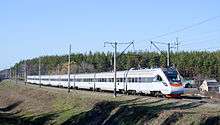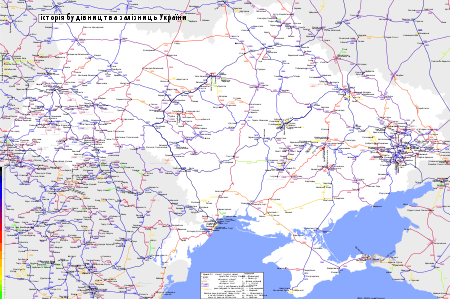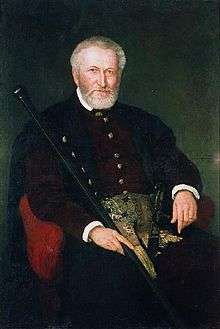Rail transport in Ukraine
Rail transport in Ukraine is a mode of transport by railway in Ukraine.
| Ukraine Rail Network | |||||||
|---|---|---|---|---|---|---|---|
 | |||||||
| Operation | |||||||
| National railway | Ukrzaliznytsia (Ukr Railways) | ||||||
| Statistics | |||||||
| Ridership | 53.7 million (2014, Ukrzaliznytsia only)[1] | ||||||
| Freight | 443.222 mln tonne (2013, Ukrzaliznytsia only)[1] | ||||||
| System length | |||||||
| Total | 21,640.4 kilometres (13,446.7 mi)[1] | ||||||
| Electrified | 9,878 kilometres (6,138 mi)[1] | ||||||
| Track gauge | |||||||
| Main | 1,520 mm (4 ft 11 27⁄32 in)[1] | ||||||
| Features | |||||||
| No. stations | 1,447[1] | ||||||
| |||||||
General scope
It consists of several components.
- Network of railways (and infrastructure e.g bridges, electrification, stations, etc.)
- Railway service providers
- Rolling stock manufacturers and repairers
The company in charge of non-mass transit railways is Ukrainian Railways which since 2015 has changed its form of ownership from state company to public.
History

Before Ukrainian Independence


Railways as a mass rail transport in Ukraine were first built under the imperial rule of the Austro-Hungarian Empire (in the western territories, Kingdom of Galicia and Lodomeria, Duchy of Bukovina and the Hungarian comitatus in Carpathian region "Karpatalja"), and later in the Russian Empire-controlled territories that held bigger portion of modern Ukraine, having seen major development and reformation since.
On territory of modern Ukraine, railroads that were used by self-propelled locomotives (in contrast to horse-drawn) appeared in 1860s on efforts of Prince Leon Sapieha. Particularly it started with the extension of the Galician Railway of Archduke Charles Louis from Przemyśl (Premissel) to Lviv (Lemberg). The first train arrived to Lemberg using the railroad on 4 November 1861.
Also during the Crimean War in 1855 British troops built a 23 km (14 mi) long railroad on territory occupied by the Allied military forces between Sevastopol and Balaklava to improve their military logistics in their fight against the Russian Empire. After the war, in 1856 the Russian authorities disassembled the road.
Later in 1860s the railroad from Lviv extended further towards Chernivtsi (at that time Czernowitz was a capital of a crown land Duchy of Bukovina) and Iași (at that time Jassy was in the Kingdom of Romania). Also in 1865 in the Russian Ukraine railroad started to be built from Odessa towards Balta.
In 1869-70 in Russian Ukrainian gubernias started a mass construction of railroad network from Kursk one west towards Kiev and another south towards Lozova (between Kharkiv and Dnipro) passing Kharkiv. Between Darnytsia and Kiev was built Struve Railroad Bridge. From Lozova railroad expanded east towards Donbas area through Sloviansk and reaching Horlivka. At about the same time the Odessa railroad from Balta through Kremenchuk–Kriukiv expanded towards Poltava providing another railroad connection of both Dnieper banks. In Kriukiv (now in Kremenchuk) was built the Kryukiv Railway Car Building Works. In 1869 from Rostov-on-Don railroad through Taganrog was extended to Horlivka. Also in Austria, the railroad extended from Lviv towards the Austria-Russia border near Brody and in 1870 extended to Ternopil (Tarnopol). In 1870 Kiev through Vinnytsia and Zhmerynka was connected with the Odessa–Balta railroad.
In 1871 there was built the first Austria-Russia border rail crossing when Ternopil was connected with Zhmerynka over Zbruch River near Volochysk and Pidvolochysk located on opposite banks of the river. In 1871 Poltava was connected with Kharkiv providing with an alternative to reach the city of Odessa and its port with the Russian central provinces through Kharkiv. In 1872-73 major expansion of railway network started in Russian Volhynia branching out of the Kiev-Odessa railroad near Koziatyn west pass Brest-Litovsk and connecting such cities like Kovel, Rivne, Zdolbuniv, Shepetivka, Berdychiv and others. In 1873 from Zdolbuniv was extended another branch towards Brody becoming another border rail crossing. Some railway network expansion took place in Donbas area as well. In 1873 from Znamianka in Central Ukraine located on the Poltava-Balta road another branch was stretched south towards the port of Mykolaiv at Black Sea making it the second seaport in Ukraine connected to network of railways. About that time a system of railroads expanded further towards the Drohobych-Boryslav oil fields and bigger Sambor areas in Ukrainian Carpathians and another rail branch was extended along Tisza River in Hungary.
In 1873-75 from Lozova railroad expanded towards Crimean peninsula connecting Sevastopol with Kharkiv through Chonhar peninsula.
For more information, see:
List of populated places established with railroads
Independent Ukraine
On 24 September 1991, following the resolution of the Verkhovna Rada (Ukraine's parliament) on separation from the Soviet Union, all railway administration was temporarily passed to the South-Western Railways. According to the resolution, all assets located within the borders of the former Ukrainian SSR became property of Ukraine. To improve efficiency a special centralised administration was created. On 14 December 1991 the Cabinet of Ministers of Ukraine issued declaration No. 356 "In creation of the State Administration of Railway Transport in Ukraine" which proclaimed Ukrzaliznytsia a government body administering railway transport in place of the previous six state railway companies.[3]
As of 2015 the Ukrainian government transformed the railways into a public joint-stock company named Ukrainian Railways (Ukrainian: Ukrainska Zaliznytsia).[4]
Infrastructure
The total length of railway network is 21,640.4 kilometres (13,446.7 mi). The length of electrified track is 9,878 kilometres (6,138 mi). There are 1,447 railway stations that have 118 various station buildings. There are 2,268 various smaller stops. The infrastructure also contains 5,422 rail crossings (level crossing), 4,168 of which have automatic signalling system. At the same time 1,497 rail crossings are manned 1,468 out of those equipped with automatic signalling system (grade crossing signals).
Rolling stock
- Diesel locomotives 2,447
- Electric locomotives 1,547
- Freight carriages 111,100
- Passenger carriages 5,291
Rail stock manufacturers and repair
Manufacturers
Locomotives
- Luhanskteplovoz, former producer of locomotives (in 2007-2016 belonged to Russian Transmashholding)
- Malyshev Factory, former producer of locomotives as Kharkiv Steam-locomotive Factory
- Dnieper Electrical Locomotive Works, producer of electrical locomotives
Carriages
- Kryukiv Railcar Works, primary producer of small locomotives and rolling stock
- Stakhanov Railway Car Building Works, passenger rolling stock manufacturer
- DniproVahonMash (Dnieper Railcar Works), freight rolling stock manufacturer
Supporting
- Kryvyi Rih Diesel Engines, diesel engines
- LuhCentroKuz, rail axles
Repair factories
- Darnytsia Railway Carriage Repair
- Dnipro Railway Carriage Repair
- Zhmerynka Railway Carriage Repair
- Kharkiv Railway Carriage Repair
- Konotop Railway Carriage Repair
- Kiev Electric Railway Carriage Repair
- Dnipro Diesel Locomotive Repair
- Poltava Diesel Locomotive Repair
- Haivoron Diesel Locomotive Repair
- Izyum Diesel Locomotive Repair
- Ivano-Frankivsk Locomotive Repair
- Lviv Locomotive Repair
- Zaporizhia Electric Locomotive Repair
Rolling stock research
- Ukrainian Research Institute of Railway Carriage Construction,[5] Kremenchuk
Other rail transport in Ukraine
Rail transport used for mass transit is usually administered by local government, typically city authorities; this includes trams, subway (metro), funicular, others.
In mountain regions, narrow gauge railway systems are sometimes privately owned.
References
- "Statistical data on Ukrainian Railways (Статистичні дані про Українські залізниці)". Archived from the original on 2017-02-04.CS1 maint: BOT: original-url status unknown (link)
- Ukraine profile, BBC News
- "КАБІНЕТ МІНІСТРІВ УКРАЇНИ П О С Т А Н О В А від 14 грудня 1991 р. N 356". Законодавство України. 30 July 1993.
- Ukrzaliznytsia officially becomes joint-stock company, UNIAN (21 October 2015)
http://en.interfax.com.ua/news/economic/299132.html - Official website. Ukrainian Research Institute of Railcar Construction.
